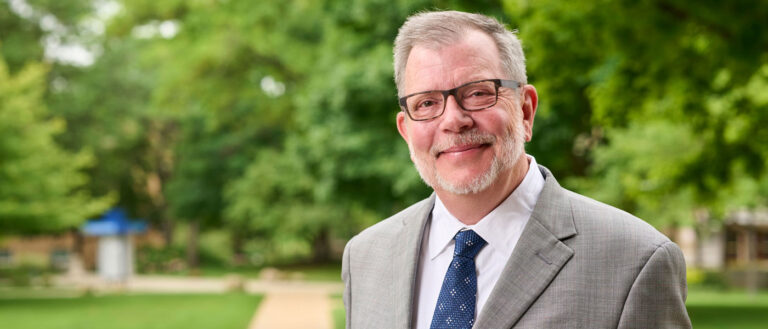Case Western Reserve’s 11th president, Eric W. Kaler, continues a 54-year legacy of leadership
Today’s inauguration ceremony for President Eric W. Kaler takes place exactly a year to the day since then-Interim President Scott Cowen sent his first “Thinking Out Loud” message to the campus community. At the time, Case Western Reserve’s COVID-19 positivity rate had more than doubled since classes began in August, with national predictions that the pandemic would only grow worse by the holidays.
Yet in that Oct. 15 message, Cowen offered only encouragement: “I have seen resilience everywhere around me during my first few weeks,” he wrote. With it, he concluded, “anything seems possible.”
The same could be said of the university itself. With roots dating back to 1826, well over a half dozen separate institutional structures over the years, and a 1967 federation of two of them not fully complete until the early 1990s, Case Western Reserve’s standing as one of the nation’s leading research universities is itself a testament to its strength and perseverance.
When trustees of the Case Institute of Technology (CIT) and Western Reserve University agreed to federate in 1967, CIT president Robert W. Morse assumed leadership of Case Western Reserve. His tenure included many of the most fundamental steps toward creating a single institution: establishing and filling key leadership positions for academics, finance, and admissions—not to mention creation of a single faculty.
His successor, then-CWRU law dean Louis A. Toepfer, became president in 1970 and led the merger of three existing undergraduate colleges into one, the federated institution’s first capital campaign, and eight years of budget surpluses—after arriving with the university facing a $4 million deficit. The end of his tenure also saw Weatherhead School of Management receive its name in honor of a $3 million gift from businessman Albert J. Weatherhead III.
Triple MIT alumnus and University of Michigan engineering dean David V. Ragone succeeded Toepfer and continued the process of creating a truly cohesive and integrated institution—including, in 1985, CWRU’s first-ever university-wide commencement. Ragone also maintained financial stability, including annual surpluses, and planted early seeds regarding the potential commercialization of university discoveries.
In 1987 Dartmouth provost Agnar Pytte became Case Western Reserve’s fourth president, and over the next dozen years transformed both the physical and technological infrastructure of the campus. Case Western Reserve completed a fiber-optic computer network in 1991 that drew national interest, and within a few years became one of the first universities with an .edu site. Pytte also led a major fundraising campaign that ultimately brought in $416.5 million—surpassing its original goal by more than $66 million. Among the projects made possible were the Kelvin Smith Library, the Veale Convocation, Recreation and Athletic Center, the Mandel School of Applied Social Sciences, and the Richard F. Celeste Biomedical Research Building.
Pytte’s successor, physicist David H. Auston, came to campus after serving as provost of Rice University. He established the President’s Commission on Undergraduate Education and Life and supported completion of a master plan to help guide the campus’ physical development in years to come—including expanded and enhanced housing for undergraduates. His provost, James W. Wagner, became interim president after Auston departed in 2001; he returned to the chief academic officer role the following year when Edward M. Hundert assumed CWRU’s presidency in 2002.
Hundert had exceptionally ambitious plans for the institution, but their significant costs, coupled with declining philanthropic support, ultimately led to his resignation in 2006. Trustee and medical school alumnus Gregory L. Eastwood became interim president that summer, and took several steps to start to restore calm and confidence on campus.
On July 1, 2007, Barbara R. Snyder became the university’s first woman president. In her first year she eliminated the university’s $20 million deficit, visited more than two dozen cities around the country to re-engage alumni, and began rebuilding philanthropy. By the time she stepped down in the fall of 2020, the university had completed a $1.82 billion capital campaign; more than tripled undergraduate applications and dramatically increased the academic quality of entering classes, and saw completion of multiple major capital projects, among them the Tinkham Veale University Center, the Larry and Sally Zlotnick Sears think[box] and the Health Education Campus with Cleveland Clinic.
After Snyder announced her departure to become president of the Association of American Universities, CWRU turned to Cowen, then a trustee and previous longtime dean of the Weatherhead School of Management and president of Tulane University, which he led during the devastation Hurricane Katrina wrought.
Cowen wrote more than a dozen more “Thinking Out Loud” messages during the course of the academic year, while also leading the institution through the evolving challenges of the pandemic. He proved right about the institution’s resilience; by March of last year, the university had partnered with the city of Cleveland to provide vaccines to residents of wards adjacent to campus, and then CWRU faculty, staff and students and, ultimately, students at other area colleges.
President Kaler’s inauguration at 4 p.m. on Friday, Oct. 15—which can be livestreamed by registering online—makes official the post he has held since July of 2021 as Case Western Reserve’s 11th president.
Learn more about President Kaler at case.edu/president.

